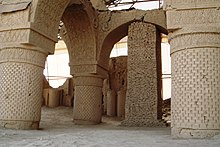| Persian: آرامگاه حاجى پياده بابا | |
 Ruins of Haji Piyada in 2008 Ruins of Haji Piyada in 2008 | |
 | |
| Location | Near Balkh, Balkh Province |
|---|---|
| Coordinates | 36°43′47.1″N 66°53′7.1″E / 36.729750°N 66.885306°E / 36.729750; 66.885306 |
| Type | ruin |
Haji Piyada Mosque (ḤĀJI PIĀDA) or Noh Gonbad Mosque (Persian: مسجد نُهگنبد "Mosque of Nine Cupolas") is a historic building in Balkh province of northern Afghanistan. It is thought to be the oldest Islamic building in Afghanistan, dating to the 9th century or possibly to the late 8th century.
History
The construction of the mosque has been traditionally attributed to the 9th century, based on its similarities with the Abbasid style of Samarra. A more recent study by archeologist Chahryar Adle proposes that the mosque was built earlier, in 794, based on a reading of historical sources, on estimates obtained from radiocarbon dating, and on a re-analysis of the decorative style. According to this hypothesis, the mosque was built on the orders of the Barmakid governor of Khorasan at the time, Fazl ibn Yahya, appointed by the Abbasid caliph Harun al-Rashid. According to Adle, the mosque was also built inside the precinct of a large, pre-existing Buddhist religious complex called Now-Bahar, which had been under the care of the Barmakid family for generations before this.

The mosque was severely damaged by earthquakes over time, possibly as soon as the year 819. All of the mosque's domes have since collapsed. The site was listed on the World Monuments Fund's 2006 World Monuments Watch list of 100 Most Endangered Sites. Prior to this, a metal roof had already been erected over the ruins of the mosque to protect it from the elements, as the structure is vulnerable to erosion.
In 2006, based on a request from Afghan authorities, UNESCO, and the French Archaeological Delegation in Afghanistan (DAFA),the site was visited by a team of experts and a representative of the Aga Khan Trust for Culture. In 2009, the conservation of the site was launched on the initiative of the Aga Khan Trust for Culture and funded by US Embassy in Kabul, Afghanistan. Reconstruction was coordinated by several scholars from the University of Florence in Italy. The first phase of work was completed in 2011. As part of the project, a larger temporary metal roof was constructed to protect the site from rain, wind and other natural disasters.
Description

The building measures 20 by 20 metres (66 by 66 ft). The outside walls are of mud-brick construction. The interior is divided into nine bays, each originally covered by a dome. The columns and the arches that divide the bays are decorated in deeply carved stucco, depicting a wide variety of designs, stylistically comparable to Abbasid decoration in Mesopotamia.
Pilgrims visit the tomb of saint, Haji Piyada, who was also buried there.
References
- ^ Petersen, Andrew (2002). Dictionary of Islamic Architecture. Routledge. p. 3. ISBN 978-1-134-61366-3.
- ^ Adle, Chahryar (2011). "La mosquée Hâji-Piyâdah / Noh-Gonbadân à Balkh (Afghanistan). Un chef d'oeuvre de Fazl le Barmacide construit en 178-179/794-795 ?". Comptes rendus des séances de l'Académie des Inscriptions et Belles-Lettres. 155 (1): 565–625. doi:10.3406/crai.2011.93171.
- ^ Bloom, Jonathan M.; Blair, Sheila S., eds. (2009). "Balkh". The Grove Encyclopedia of Islamic Art and Architecture. Vol. 1. Oxford University Press. p. 258. ISBN 9780195309911.
- Ettinghausen, Richard; Grabar, Oleg; Grabar, Professor Emeritus of Islamic Art and Architecture Oleg; Jenkins, Marilyn (2003). Islamic Art and Architecture 650-1250: 2nd Edition. Yale University Press. p. 109. ISBN 978-0-300-08869-4.
- ^ Boostani, Arash; Fratini, Fabio; Misseri, Giulia; Rovero, Luisa; Tonietti, Ugo (1 July 2018). "A masterpiece of early Islamic architecture: The Noh-Gonbad Mosque in Balkh, Afghanistan". Journal of Cultural Heritage. 32: 248–256. doi:10.1016/j.culher.2018.02.001. ISSN 1296-2074.
- ^ "Haji Piyada Mosque (Noh Gumbad)". World Monuments Fund. Retrieved 22 January 2024.
- World Monuments Fund's World Monuments Watch 1996-2006. – Retrieved on 12 November 2008. Archived 5 January 2009 at the Wayback Machine
- "The mysterious, ancient Nine Domes Mosque of northern Afghanistan". France 24. 6 January 2018. Retrieved 22 January 2024.
- "Masjid-i Haji Piyadah". Archnet. Retrieved 22 January 2024.
- Archaeological gazetteer of Afghanistan (Title in French: Catalogue des sites archaeological d'Afghanistan), Warwick Ball, Volume I & II, Editions Recherche sur les civilisations, Paris, 1982.
This article relating to archaeology in Asia is a stub. You can help Misplaced Pages by expanding it. |
This article about a mosque or other Islamic place of worship in Afghanistan is a stub. You can help Misplaced Pages by expanding it. |